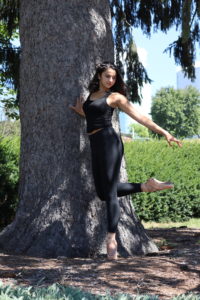Photo by Claudia Garber
[ID: A ballet dancer stands on pointe during a performance of Swan Lake, her arms slightly bent by her side. She is a young woman with dark hair and is wearing a long white tutu and a feather headpiece. She looks down towards the ground, while three other ballet dancers bow down by her feet.]
A young woman is kidnapped and tortured. When a man promises to save her, he falls through on his word. She kills herself, realizing she would be happier in death than she is in life.
A young woman learns she is in a relationship with a married man. Publicly humiliated, she is called crazy and dies amidst her betrayal and shame.
A man leaves his fiancé to pursue his fantasy woman. Unable to tame her, he wraps her in straitjacket-like silks, killing her instantly.
A temple dancer is caught amidst conspiracy and scandal when her lover agrees to marry another woman. After their infidelities are revealed, those in power first shame and then murder the young dancer.
These are the four most popular librettos in the classical ballet repertoire. Swan Lake, Giselle, La Sylphide, and La Bayadere are collectively referred to as the “White Ballets” after their second acts, where the corps de ballet appear in all white. Each ballet is over a hundred years old, but every major ballet company in the world continues to perform them, often without revisions. They are pillars of the classical ballet repertoire; ballet masters, choreographers, and directors scoff at the mere suggestion of tampering with the classics. If the ballet world loves anything, it’s tradition.

[ID: A young, white woman in her early twenties stands smiling against a red wall. She has dark hair pulled back into a ponytail, and she is wearing a black turtleneck and dangling, sparkly earrings.]
Like many young girls, I was seduced by the fairytale escapism that classical ballet promised me. My walls were adorned with paintings of tutu-clad dancers and signed pointe shoes. I watched performances of each ballet on repeat, memorizing the steps and score as if they were song lyrics. Later in my training I would perform excerpts and variations from the White Ballets. Donning layers of white tulle and rib-shackling corsets, I stood in militaristic-like ranks of swans, shades, and willis.
It was not until my first year of college that I asked myself why women were always dying in classical ballets. Now entering my senior year, this question still haunts me.
Truth be told, the female protagonists in my favorite ballets weren’t exactly women. They were swans and sylphs. Ghosts. Hallucinations. Fairies. Woodland creatures. Just woman enough to feel the pain of their misfortunes, yet fantastical enough to dance through it. They were chaste visions in bridal white. Men fell in love with them upon first glance. Their lives? Easily disposable. At best, they were granted the common courtesy of symbolizing eternal love: their suffering a metaphor for grace and forgiveness. They could pirouette and jete with ease, but never yell or stand firmly on two feet. They drowned in lakes of their own tears and danced to their graves, pointing their feet even in the afterlife.
These are stories of women suffering, usually at the hands of men; stories of women being shamed, harassed, exploited, and killed. I won’t argue that we shouldn’t be telling these stories. On the contrary, in a post-#MeToo society these stories have never been more necessary. The problem lies in how the ballet community continues to tell them.
These stories are always framed around the male protagonist, always told from their point of view. Despite the centrality of Odettte’s suffering to the plot of Swan Lake, it is Prince Siegfried who appears in all four acts, his perspective driving the narration. Giselle’s death is a mere precursor to Albrecht’s realization that he will have to live without her. La Bayadere and La Sylphide are no different. These may be stories of women suffering, but the real tragedy is always the man’s grief.
And these are stories of white women suffering. Though these ballets are framed as tragic romances, they are also not-so-subtle glorifications of white femininity. They are celebrations of heteronormative, cisgendered, Eurocentric norms, designed to bar anyone who doesn’t fit into the perfectly crafted mold from dancing.
Ballet’s gatekeepers will justify all of this for the sake of tradition. The classical repertoire is sacred, we must keep it pure at all costs, must protect the aesthetic and never question our ancestors. This is ironic, considering the Bournonville and Petipa choreography that the ballet world has desperately clung to in the last century is itself a revision of previous versions. The original 1836 version of La Sylphide has been long lost. Though Giselle was first choreographed in 1841 Paris, today we perform the Russian choreography from 1884. Swan Lake, arguably the most iconic ballet in the modern canon, failed upon its initial premier. The 1895 revival, which has survived untouched until today, made major revisions to the plot, score, and choreography.[1]
So the ballet “greats,” or rather, the white men who created these ballets—Petipa, Bournonville, Ivanov—were already working with revisions. Choreographers today need not feel beholden to any particular version—there’s no pure form.
Truth be told, it shouldn’t be so daunting to touch these works, but because the ballet community puts them on such a high pedestal, it feels as such. There are those who have dared to touch the classics. Matthew Bourne’s Swan Lake, which features a nearly all male cast, is itself now a modern classic. Dada Masilo’s Giselle integrates South African dances and reimagines an ending where Giselle refuses to forgive Albrecht, leaving him to die. Shobana Jeyasingh explores the origins of orientalism and exoticism in her ballet, Bayadere — The Ninth Life. Others—Akram Khan, Alexander Ekman, Seeta Patel—have produced their own re-imaginings.

[ID: A young, white woman in her early twenties poses on pointe by a tree, one foot bent behind her. She has shoulder-length, dark hair and she is wearing a black tank top and black leggings.]
For ballet to survive, this work must continue. Still, I would argue that there is room in the ballet repertoire for new librettos. Reimagining the classics is great, but it’s time the ballet community creates a space for the stories that have yet to be told. It’s time that women—including Black women, queer women, and trans women—tell their own stories on the ballet stage. We can tell stories of women suffering. We can tell stories of betrayal, shame, and pain. Yes, we can even tell simple love stories. But to do these stories justice, we must strip them of the white male gaze that has haunted the ballet canon for centuries.
But what is to become of the classical repertoire? Is there any possibility of salvaging the original ballets? Is it enough to host post-show conversations or provide program notes, acknowledging the weight these works carry? Should ballet companies perform them in a purely historical context, or remove any plot from the choreography? Is it time we dancers retire our tutus, pack up the tulle and feathers, and abandon the White Ballets once and for all?
I believe the future of these ballets is complicated, and these answers will take time. Although they are a deeply flawed tradition, these ballets are also deeply loved. The first time I danced the second act of Swan Lake, I remember hugging my fellow corps dancers in the wings, tears streaming down our faces. Overwhelmed with emotion, one girl turned to me and said, “Think about all of the dancers who have danced these steps before us. We’re joining a part of something so much bigger than any one of us.”
For many dancers, performing these ballets is not only an artistic release, but an empowering display of their power and strength, a testament to the comradery felt between dancers, and a chance to take agency in their training. Ballet is a paradox, for as valid as these feelings may be, there is clear tension between this kinesthetic experience and the narratives that continuously disempower women.
We have not seen the end of the White Ballets. Having already survived centuries, dancers will continue to pass down the steps and score, and audiences will continue to fill theaters, eager to see the women in white. And while the steps on stage remain unchanged, the world outside will continue to rapidly evolve. The ballet community must realize that their art does not exist in a vacuum. Though tradition is incredibly sacred to the art, eventually our dances must reflect the world around us.
Recently, the four-year-old girl I teach ballet to asked me to teach her the “swan dance” she had seen illustrations of in a picture book. I demonstrated raising my arms above my head, bringing my wrists together, palms facing outwards, then letting my arms float down once more. There we stood, facing each other, performing the iconic choreography and I wondered where this art form would take us, and where we would take it.
[1] Homans, Jennifer. Apollo’s Angels: A History of Ballet. Random House, 2010.
This article appeared in the Fall 2021 issue of In Dance.


